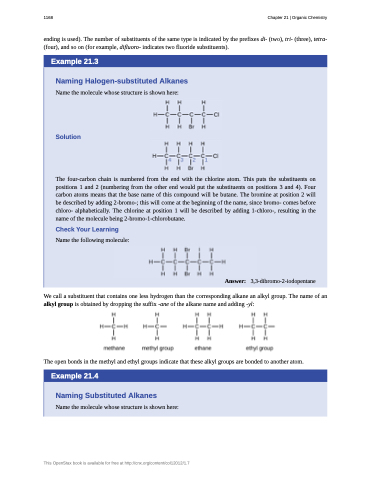Page 1178 - Chemistry--atom first
P. 1178
1168 Chapter 21 | Organic Chemistry
ending is used). The number of substituents of the same type is indicated by the prefixes di- (two), tri- (three), tetra- (four), and so on (for example, difluoro- indicates two fluoride substituents).
Example 21.3
Naming Halogen-substituted Alkanes
Name the molecule whose structure is shown here:
Solution
The four-carbon chain is numbered from the end with the chlorine atom. This puts the substituents on positions 1 and 2 (numbering from the other end would put the substituents on positions 3 and 4). Four carbon atoms means that the base name of this compound will be butane. The bromine at position 2 will be described by adding 2-bromo-; this will come at the beginning of the name, since bromo- comes before chloro- alphabetically. The chlorine at position 1 will be described by adding 1-chloro-, resulting in the name of the molecule being 2-bromo-1-chlorobutane.
Check Your Learning
Name the following molecule:
Answer: 3,3-dibromo-2-iodopentane
We call a substituent that contains one less hydrogen than the corresponding alkane an alkyl group. The name of an alkyl group is obtained by dropping the suffix -ane of the alkane name and adding -yl:
The open bonds in the methyl and ethyl groups indicate that these alkyl groups are bonded to another atom.
Example 21.4
Naming Substituted Alkanes
Name the molecule whose structure is shown here:
This OpenStax book is available for free at http://cnx.org/content/col12012/1.7


